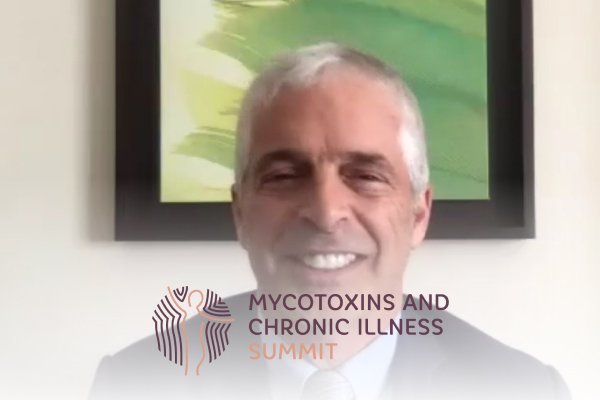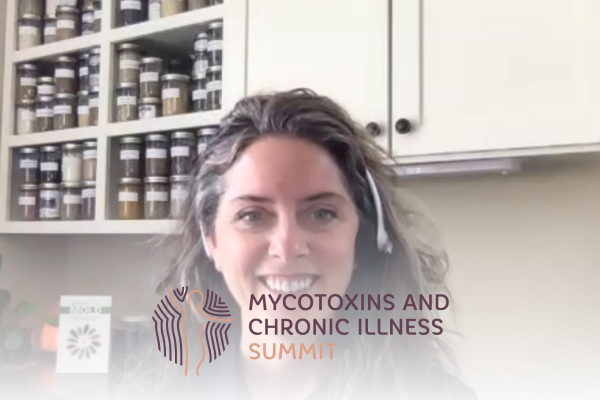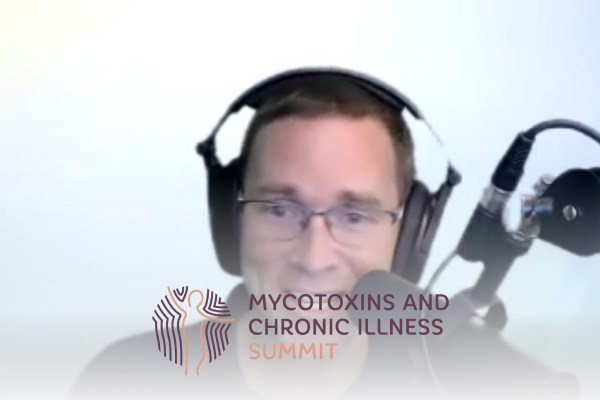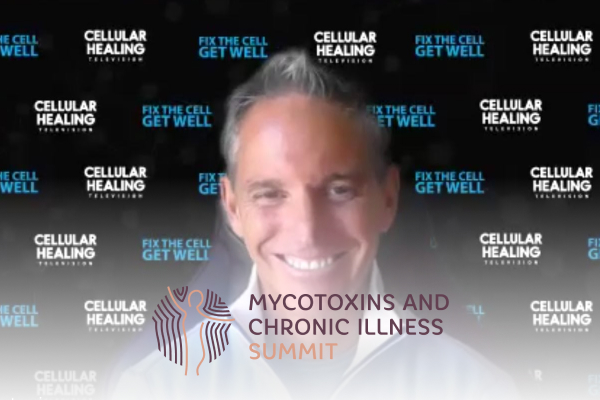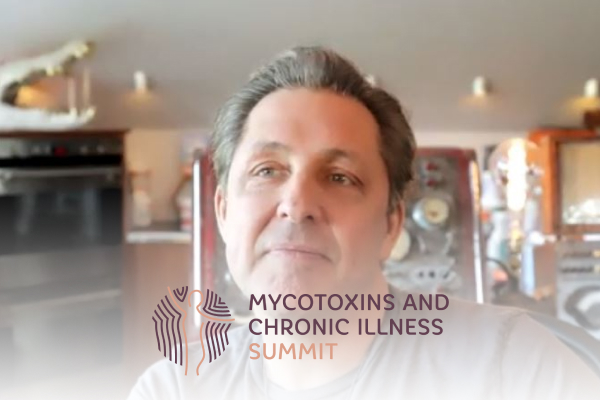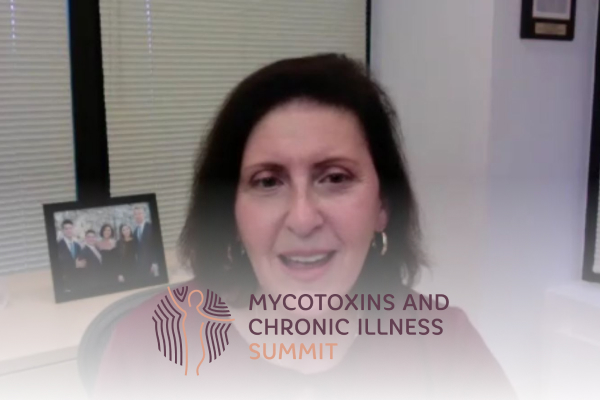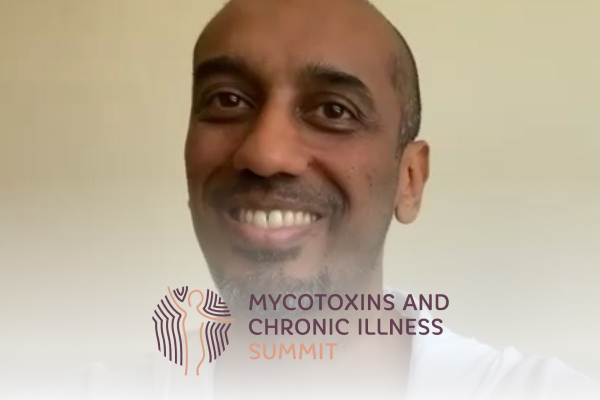Join the discussion below

Eric Gordon, MD is President of Gordon Medical Research Center and clinical director of Gordon Medical Associates which specializes in complex chronic illness. In addition to being in clinical practice for over 40 years, Dr. Gordon is engaged in clinical research focused on bringing together leading international medical researchers and... Read More

Tom O’Bryan, DC, CCN, DABCN, CIFM
Dr. O’Bryan is considered a ‘Sherlock Holmes’ for chronic disease and teaches that recognizing and addressing the underlying mechanisms that activate an immune response is the map to the highway toward better health. He holds teaching Faculty positions with the Institute for Functional Medicine and the National University of Health... Read More
- Dr. O’bryan’s story
- Auto immune fix
- Metabolites
Eric Gordon, M.D.
Welcome. Welcome to another edition of Mycotoxins and Chronic Illness Today it’s a real pleasure to have a chance to get to know Dr. Tom O’Bryan. I think one of the exciting things about doing this series has been the number of thinkers that I’ve gotten to meet and learning all the time. I mean, it’s something that is just special and it’s part of medicine. It’s the heart and soul of medicine that I think often gets lost. But doctors like Tom O’Bryan who dive deep into the underlying science and bring back to the practitioners like us the new way of thinking about things. Dr. Tom O’Bryan has written several books, “The Autoimmune Fix” and most recently “You Can Fix Your Brain.” And I think we’re gonna talk a lot about fixing your brain because chronic illness almost always affects the brain. So Dr. O’Bryan tell me just what… just what, I guess, I always like to know, like what got you started? What got you excited about autoimmunity and then later the brain?
Tom O’Bryan DC, CCN, DACBN, CIFM
Ah, well, I’d have to go back 41 years. My ex and I were unable to get pregnant. I was an intern at the time, and I called the seven most famous holistic doctors I’d ever heard of and asked the office manager if I could speak with them. And they all came on the line said, hello, this is Dr. Goodheart. How can I help you? And I’d say hi. And he said, yeah, yeah. What can I do for you? I said, well, we can’t get pregnant, and I’m wondering where do you begin to look? He said, well, you know what a category one is? I said, no. He said, learn. I said, okay, category one. And every one of these doctors, they told me what their thinking was. I put a program together and we were pregnant in six weeks.
Eric Gordon, M.D.
Okay, that’s…
Tom O’Bryan DC, CCN, DACBN, CIFM
My neighbors in married housing asked if I’d work with them because they’d been through artificial insemination and nothing had worked, and I said, well, you know, I don’t think it’s gonna hurt you, sure. They were pregnant in three months.
Eric Gordon, M.D.
Okay.
Tom O’Bryan DC, CCN, DACBN, CIFM
So we were hot to trot before I got out in practice, you know, and we were happy being pregnant. We tell our friends and our friends would tell their sister in Wisconsin. We lived in Chicago, and sister would drive down from Wisconsin to see me in my dorm room. And so we just wanted to help people. And, as you know, there’s not much in medicine, that’s all or every, but this was every. Every person that had reproductive concerns, whether it was premature ejaculations or unexplained miscarriages, every person had as one of the triggers going on some foods that they were eating that they didn’t know were inflammatory for them.
So they were fueling more inflammation, and the most common food was wheat. And so that started me in 1979 on this journey about wheat and its impact in the body, and I did the Gluten Summit. It was the first health summit online in 2013. And I interviewed 29 of the world experts and just dropped people’s jaws. And so when you hear the chair of hypertension at Vanderbilt University talk to us about the endothelium, the inside lining of the blood vessels, and how the inflammation from eating wheat can trigger that endothelium to start calcifying, and this is from the head of the Hypertension Institute, your jaw drops, and so from there with this whole thing about wheat, I realized, and I’ve been following Professor Alessio Fasano now for many, many years.
Eric Gordon, M.D.
Ah, that’s… Okay, keep going. No, no. We had him at a conference that we did in 2008. He was just starting out and yeah, no, he’s quite, anyways keep going, but he was quite, at that point a very interesting young man.
Tom O’Bryan DC, CCN, DACBN, CIFM
This is really important. You know, now he’s Professor of Medicine, Harvard Medical School. Professor of Nutrition, Harvard School of Public Health. The Director of the Celiac Center, Harvard. The Director of Mucosal Immunology, Harvard, The Chair of Pediatric Gastroenterology at Mass General at Harvard. Five positions where he’s leading the direction. Any one of these positions, any one would be a lifetime goal for someone at the top of the field.
Eric Gordon, M.D.
Yes, yes.
Tom O’Bryan DC, CCN, DACBN, CIFM
And he’s always careful of what he says, always careful so that he’s not misquoted. A paper that he published last year says it all, Dr. Gordon, says it all. All disease begins in the leaky gut. The role of zonulin, that’s the protein with leaky guts, the role of zonulin in the etiopathogenesis of chronic inflammatory diseases. And he outlines the five factors in the development of all chronic inflammatory diseases. And I consider this the paradigm that everyone needs to think about when something’s out of balance, that you look through these lenses, okay, let’s look at the five pillars. Genetics, okay, you can’t do anything about that, but genes don’t turn on and off.
Genes are on a dimmer switch and they dim up or you dim them down, but they rarely turn on or off. The second is environmental triggers. That means, and the most common environmental trigger’s what’s on the end of your fork. So what you’re putting in from the environment gets its hands on your genetics and the weak links in your genetics to turn them up for inflammation or turn them down for inflammation. The third of the five pillars, the environmental triggers create an altered microbiome in your gut. The altered microbiome creates all this inflammation in the gut, which creates number four, the leaky gut.
When you have the leaky gut, larger molecules get through the leaky gut into the bloodstream before they’ve been broken down small enough. They’re too big. They’re called macromolecules. They get into the bloodstream, and your immune system trying to protect you says what’s that? I can’t use that to make a bone cell or a brain cell. I better fight that. And now you get systemic inflammation from the macromolecules and that inflammation manifests wherever your genetic weak link is. That’s Professor Fasano’s.
Eric Gordon, M.D.
Yeah. Very nicely put together. I like that very much. And the thing I always like to emphasize to people is that in chronic illness it’s usually not something that’s trying to kill you. It’s usually your body’s response to something trying to protect you, your own response that’s causing the damage. And that’s where medicine doesn’t do well because we’re still… that’s why we need thinkers like you who are looking at a little higher level rather than just find the trigger.
Tom O’Bryan DC, CCN, DACBN, CIFM
You know, you’re one of the few guys who sees it that way and who’s a teacher. That our immune system is trying to protect us. So the question is, what’s it trying to protect you from? And that’s what you have to address is the environmental triggers as a primary component to any treatment protocol. Of course, you want symptom relief. Of course you do, but symptom relief is not going to fix the five pillars, and the three in the middle are the ones that we’ve got complete control over. Environmental triggers, microbiome, and leaky gut.
Eric Gordon, M.D.
Well, that’s what I wanna hear a lot more about. ‘Cause controlling and understanding them is not always easy, but there’s a lot of I guess… And that’s what you’re gonna tell us about. the easy ones, the ones that we can make a big difference in our lives with if we just pay attention to. So how have you put this story together? So let me hear more of your story.
Tom O’Bryan DC, CCN, DACBN, CIFM
Well, this is the Mycotoxin Summit, and so let’s talk a little about that one.
Eric Gordon, M.D.
Okay.
Tom O’Bryan DC, CCN, DACBN, CIFM
What we know now about mycotoxins, they’re something in the environment whether, you know, I still remember it was the middle of the night I woke up. I was hungry, so I stumbled out into the kitchen. I opened the refrigerator door, but I turn away ’cause I don’t want the bright light, you know, I don’t wanna wake up, and I kind of reach in there and I grab the raspberries, and I close the door and I’m eating the raspberries, and I didn’t quite eat ’em all, so I put some back, and I come back the next morning and open it, and I see the raspberries have white mold on ’em. I said, oh, no, oh, no. So we’re exposed to mold and mycotoxins
Eric Gordon, M.D.
Yeah, all the time.
Tom O’Bryan DC, CCN, DACBN, CIFM
Yeah, all the time. And what we now know about mold and mycotoxins is they create an exhaust. It’s called the metabolites of these mycotoxins that kill the good bacteria in your gut, and they feed not good bacteria in your gut creating a more inflammatory environment, the key term is dysbiosis, which then can cause the leaky gut, and now you’re off to the races with systemic problems. The mold can get in systemically, the mycotoxin metabolites get in systemically, they travel in the bloodstream, they go up to the brain, they go through the blood brain barrier. So the whole process begins with our microbiome in the gut.
Eric Gordon, M.D.
And do you have favorite ways of looking at this or how are you evaluating, you know, what’s the more inflammatory issue? I mean, you just have classes of foods that, you know, like I say, we know that most of the people are reacting to wheat and dairy sometimes, but what’s your weigh in?
Tom O’Bryan DC, CCN, DACBN, CIFM
Well, there’s two. practically every new patient I see, I recommend two tests to begin with and then whatever their symptoms are.
Eric Gordon, M.D.
Right.
Tom O’Bryan DC, CCN, DACBN, CIFM
The first one is called the Wheat Zoomer because it’s a blood test where you zoom in on the problem, and there’s never been a technology for accuracy, like silicon chip technology, which is what this laboratory is using. There’s never been anything so accurate. And we rarely, rarely find someone comes back negative even when they’ve been gluten free for a year or more. And the sensitivity and specificity is so high people are confused, and it’s cross-contamination. They’re getting inadvertent exposures or it’s because of something called molecular mimicry. If you’re sensitive to dairy and you don’t know it, but you’ve taken wheat out of your diet, and you eat the dairy, your immune system gets activated and you can still make wheat antibodies even though you’re not eating wheat, that’s called molecular mimicry.
Eric Gordon, M.D.
Yeah, and just sometimes when you just stimulate the immune system, we wind up doing things like that, getting it because we run into that problem with the infections that we look at. Many times, we think we’re seeing a bunch, we’re only seeing one, but we got the immune system activated. And you like this, that’s very, very good. You’ve found clinically the Wheat Zoomer is really…
Tom O’Bryan DC, CCN, DACBN, CIFM
Critically important, yeah, because 78 to 80%, according to the British Medical Journal of all the prebiotics in our diet, in the Western diet today, come from wheat. So that means everyone is eating wheat every day, and not everything in wheat is bad for you. The prebiotics in wheat that feed the good bacteria called the probiotics, the prebiotics in wheat feed the probiotics. So when you take wheat out of your diet, if you don’t know how to do it properly, and starting gluten-free foods which is just white paste, the result is you starve the good bacteria in your gut. You feel better at first because your inflammation goes down. But by starving good bacteria for months and months and months and not replenishing with other prebiotics, the result is you start getting sicker in six months or a year than you were before. It’s very, very common. So you have to learn how to do a gluten-free diet properly, and then it’s the healthiest thing in the world for you.
Eric Gordon, M.D.
Okay. So I’m assuming that you’re not big on a lot of the gluten free replacement foods that people are buying off the shelves.
Tom O’Bryan DC, CCN, DACBN, CIFM
If I can be non-professional for a moment, they’re crap. They’re crap. It’s white paste, and there’s nothing wrong with gluten. I’m half Italian, so I like a gluten-free pizza every once in a while. Maybe once every couple of months, I’m gonna have a gluten-free pizza, but I don’t live on that stuff every day. You can’t. You have to learn how to replenish the prebiotics in your diet with healthy prebiotics. That’s a critical component of rebuilding the diversity of your microbiome to get a good healthy microbiome.
Eric Gordon, M.D.
Yeah, yeah, and just to step back for a minute, I mean, the inflammation in the gut is probably one of the big destabilizers that allows people to then become sensitive to mycotoxins because, you know, as we were saying earlier, when you ate those moldy raspberries, I mean, you know, it’s, we’re exposed to mold and mycotoxins in a constant flow, and we’ve discussed this several times in people looking at testing and the issues with testing, how much microtoxins are in the food supply, but it’s our ability to deal with them is what’s really… and your excellent points are just, I mean, and what I love is that I just wasn’t aware of how much we depended, with our regular diets on wheat as a source to keep what could be a healthy flora, maybe if the wheat had not been altered because if you remember your whole experience started in 1979, 1980, you know, ’cause as I said infertility was not on a rampage until probably the 70’s, 80’s, that’s when it… you know, before that it was fairly uncommon.
Tom O’Bryan DC, CCN, DACBN, CIFM
Right, right. Well, back in the 80’s it was one couple out of five were having problems, now it’s more than that, I don’t know the current number.
Eric Gordon, M.D.
But it’s, no, it’s a lot. And one out of five was high. I mean, it just wasn’t like that. It was unusual. So you were seeing the beginning of the issues, and I just realized this, that, you know, I mean, there’s a whole issue of what’s happened to the wheat supply as well as what’s happened to everything else. ‘Cause like you said, you’re Italian and people were doing okay.
Tom O’Bryan DC, CCN, DACBN, CIFM
Well, people didn’t know. You know, our testing was not available. The only testing that still most doctors only use is to test for one of the clumps of poorly digested wheat called alpha gliadin. And it’s, you know, it’s a good test, but there are 62 different components in wheat that trigger the immune system. Why are we only checking one? And unfortunately, that’s all that was available in the 1990s and 2000, and most doctors are still using those laboratories that came up with those tests back then. It’s a good test, but it’s not complete. So the problems with wheat have been around for a long time. GMO didn’t come on the market until the mid 90s, and that makes it worse, but that’s not the culprit. The culprit is wheat. I mean, even the ancient strains of wheat like Spelt and Kamut, they trigger the same immune response if you have accurate testing to identify them.
Eric Gordon, M.D.
So that is fascinating that the problem has always been there. It’s just that what’s changed. Well, something has changed because I think we still didn’t have as many autoimmune diseases as we have now. So we definitely changed the environment.
Tom O’Bryan DC, CCN, DACBN, CIFM
Yeah. I can tell you what’s changed with the immune diseases, I believe. Humans never before in history have been exposed to all of the chemicals that we are now exposed to on a daily basis. It was the Toxic Substance Control Act of 1976, which is still the regulating federal guidelines for the introduction of chemicals into our environment. And it’s 247 pounds of chemicals per person per day manufactured or imported into the United States. 247 pounds, that’s five 50 pound bags for every person every single day of these chemicals that are being brought into our environment. And as you know, but our listeners might not, every newborn baby that’s tested has over 200, some studies say 280 chemicals in the umbilical cord blood at birth that are not supposed to be there, and many of them neurotoxins.
Eric Gordon, M.D.
And that’s only the ones we can test for.
Tom O’Bryan DC, CCN, DACBN, CIFM
That’s right because those tests, the laboratories don’t do those tests. They’re very sophisticated tests to identify the chemical.
Eric Gordon, M.D.
Yeah, yeah, exactly. They’re mass spec…
Tom O’Bryan DC, CCN, DACBN, CIFM
It was $10,000 per person.
Eric Gordon, M.D.
Yeah, they’re mass spec tests, and I always tell people, you only find what you’re looking for with a mass spec. There could be something toxic in there, and you just won’t see it unless, you know, to ask to look for it. So it just lets us know this is a huge, huge issue, and I love the way you’re tying it together because the… Again, this is going back to the gut because I wanna let you go. I’m stopping, so keep going.
Tom O’Bryan DC, CCN, DACBN, CIFM
All right, if I may.
Eric Gordon, M.D.
So wheat is your biggie.
Tom O’Bryan DC, CCN, DACBN, CIFM
If I may, there’s one study I’d like to give as an example. 2016 in Chicago, 346 pregnant women in the eighth month of pregnancy, they collected the urine, and they ran urine tests looking at five different types of phthalates. Phthalates are chemicals used to mold plastic, and one many of us have heard of is BPA. And they categorized the results of the urine test into fourths. The lowest fourth, the women with the lowest amount. The next amount, the third, and the highest amount. They then followed the children of these pregnancies for seven years. And when the kids turned seven years old, they did Wechsler IQ tests on them, the official IQ test. There’s not much in medicine that’s all or every. This was every.
Every child whose mother was in the highest quartile of phthalates in urine in pregnancy compared to the children whose mothers were in the lowest quartile, every child over here in the highest quartile, their IQ was 6.7 to 7.4 points lower. Now, that doesn’t mean anything to anybody until you understand a one point difference in IQ is noticeable. A seven point difference is a difference between a kid working really hard getting straight A’s, and a kid working really hard getting straight C’s. This kid doesn’t have a chance in hell of ever doing good in school because mom was high in phthalates in pregnancy and didn’t know it. Now just go to Google and type in phthalates and neurogenesis, nerve growth. Here come the studies. So where did mom get these phthalates?
Well, nail polish within four to five minutes, the phthalates in nail polish are in your bloodstream. Now there’s no evidence that the amount of phthalates that leach out of nail polish into your bloodstream are toxic to humans. That’s what the Toxic Substance Control Act demands is that you have to show that these minuscule amounts harm humans. They don’t, but these things accumulate for 25 years, for 30 years. Or the plastic storage containers that you put the leftover food into the refrigerator. The next day the chicken’s got phthalates in it. Now there’s no evidence that the amount of phthalates that leach out of plastic storage containers is toxic to humans.
That’s how they get away with this, but we’re taking all this in and there’s more and more chemicals, 247 pounds per person per day, coming into the country, and our bodies are walking sewage dumps. I’m sorry to be so blunt. And our immune systems are trying to fight all this stuff, and they don’t know how to do it because your immune system is the exact same immune system as your ancestors 5,000 years ago. And the only thing our ancestors had to fight was bugs, parasites, viruses, mold, fungus, and bacteria. Not Bisphenol A or Red Dye Number 42 or flame retardants that are in your bedsheets that outgas in the air.
Now there’s no evidence that the amount of flame retardant that outgas in bedsheets is toxic to humans, right. Or the plastic blinds on the windows that outgas phthalates into the air. Now there’s no evidence that the amount of phthalates… That’s how they get away with all this. And in the meantime we’re absorbing all of this, your immune system, trying to protect you, is going after all this stuff, and that’s what creates the inflammation that triggers wherever your genetic weak link is. That’s the development of your autoimmune diseases.
Eric Gordon, M.D.
And I just wanna emphasize that was beautifully put because I mean, first of all, the government only recognizes death or obvious disease and obvious disease doesn’t occur with low-level toxicity. I mean, it’s pretty obvious, but it’s not, and just it’s why we’re swimming in this. But the other important thing is just for people to understand that your genetics determines, you know, what flavor of illness you will get. All of us are gonna get something.
Tom O’Bryan DC, CCN, DACBN, CIFM
No, no, no, no. Your, excuse me… Your genetics determine what flavor of illness you’re vulnerable too.
Eric Gordon, M.D.
You’re vulnerable, thank you. Thank you, that’s a much better way to put it, yes.
Tom O’Bryan DC, CCN, DACBN, CIFM
You just want the dimmer switch to dim down for that, and how do you do that? You have to learn what are the environmental triggers that my immune system is fighting, and that’s gonna take you six months to a year to learn. Now, this is an important concept for your readers. The subtitle of my book, “You Can Fix Your Brain”, such a simplistic title. You know, we went through so many titles with the publisher, and I said, no, I just want this, right. But the subtitle is “Just One Hour a Week to the Best Memory, Productivity and Sleep You’ve Ever Had.” It’s not a cutesy subtitle.
It’s the only way I believe anyone can be successful in arresting and reversing their autoimmune conditions whether it’s in their brain or wherever it is, is every Tuesday night after dinner, every Sunday morning after services, whenever it is. But every week you tell your family, I’m allocating one hour to learn a little more about how we all can be healthy, don’t bother me. And then you go to my book and you look for the three URLs about glass storage containers. And so if you go to mileskimball.com and you look at those, and you go to Amazon, and you look at the third one, I don’t remember what it was.
And you say I love those, and then you order three round ones, two square ones, one for the pie, you pay with your credit card, hit send. it took you an hour, but you’re done for the week. And next week you do nail polish. And next week you do air filtration systems in your house. And next week you do sleeping equipment. And you just learn, but a little bit ’cause it’s so overwhelming it’ll blow you away, and you throw the baby out with the bath water. It’s too overwhelming if you try to change everything. Now I’ll give you one more point to this. I’m sorry, but…
Eric Gordon, M.D.
Oh, no, go, go, go. You go. You’re great.
Tom O’Bryan DC, CCN, DACBN, CIFM
1986, a gastroenterologist in Australia wrote a paper and said, you know, I think that sometimes ulcers are caused by a bacteria, and all the other gastroenterologists said, what are you a nutcase? Everybody knows ulcers are caused by too much acid, and you have to give antacids. He didn’t care. He knew he was right that sometimes. What did he do? He did an endoscopy, put a tube down his throat with a camera, took a picture of the healthy pink tissue in his stomach. Then he drank a beaker of bacteria, a beaker of a bacteria called Heliobacter pylori. Then he waited five days until he was as sick as could be. Did another endoscopy, took pictures of the ulcers that were forming in his stomach. Then he took the antibiotics to kill the bacteria, waited about 10 days until he felt good again. Did another endoscopy and showed the picture of the healing of the stomach, published the papers with the pictures.
Then everybody knew he was a nutcase, but he proved that sometimes ulcers are caused by bacteria. Now the World Health Organization thought that was so important, they sent a message to every medical society in the world. Send this paper out to all of your members. Why? Because stomach cancer was the number one cancer killing people, and it’s often caused by a Heliobacter infection. So if doctors were to look at this when people have upset stomach and heartburn and not just prescribe antacids right away, they might reduce the risk of stomach cancer. And they did, it was very successful. But Dr. Barry Marshall didn’t care, they still thought he was a nutcase. 21 years later, he wins the Nobel Prize in medicine.
And this is the exact quote from the Nobel Committee to Dr. Barry Marshall and his partner who with tenacity and a prepared mind challenged prevailing dogma. You wanna challenge the direction your health is going. You need tenacity. That’s one hour a week. Well, then what do you do? You prepare your mind by watching this interview, by watching other interviews in this summit, by reading books for one hour a week, you prepare your mind to challenge the prevailing dogma, and that’s how you win your Nobel Prize in health.
Eric Gordon, M.D.
I like it. And I gotta get your book ’cause, you know, I’m one of those people. Oh, yes, yes, yes. And then you change one thing and then you wait another three months until you walk into the wall again, you know. I love that concept because, you know, for those of us who are busy and, you know, easily distracted, one hour a week is a doable goal.
Tom O’Bryan DC, CCN, DACBN, CIFM
Yeah. I think that’s the only way to be successful to stop this true pandemic that’s happening about autoimmune diseases and brain dysfunction. You know, one study on brain dysfunction that just shocked me, just shocked me. Blue Cross Blue Shield, arguably the largest for profit health insurance company in the English language, published a paper in February of last year. And they said, we got a problem that the incidence of diagnosis of early stage Alzheimer’s dementia in 30 to 45 year olds between 2013 to 2017 in four years went up 406%. Not 10%, not 20%, fourfold, 406% in four years. That our younger generation is experiencing the end stage inflammation damage that took our generation decades because it wasn’t as bad. It’s so much worse now, and also because of what their eyes on computer screens and Nintendo games when they were kids and all of that inflammation that comes from there. It’s so much worse now that we’re seeing end stage Alzheimer’s indicators, mild cognitive decline and mild Alzheimer’s in 30 to 45 year olds, 406% increase in four years.
Eric Gordon, M.D.
That’s mind blowing. That’s truly mind blowing.
Tom O’Bryan DC, CCN, DACBN, CIFM
It is.
Eric Gordon, M.D.
Yeah. No, and yeah. We’ll get your book quick.
Tom O’Bryan DC, CCN, DACBN, CIFM
Well, this summit about mycotoxins, how does that fit in? They’re one of the environmental triggers that’s extremely common that we’re exposed to. And especially people that don’t think they’ve got mold in their house. You know, if your basement flooded and you cleaned it up, you know, you put a dehumidifier down there, you took the carpet out, dried it out and put it back, but the drywall got wet and the dehumidifier took it out of there. Well, the backside of the drywall may have black mold growing in there and you’d never know it. You’d never know.
Eric Gordon, M.D.
Yep, yep. It’s there, and you know when we talked about it when we had Dr. Ritchie Shoemaker on, and, you know, his newer research is really showing something that most of us realize it’s not just the molds, it’s the other bacteria that grow. Anytime you have water damage, they’re growing. And again, they’re not there to hurt us, but when they overgrow and our defense system isn’t good, they’re gonna ’cause this inflammation or they’re gonna aggravate. And that’s why I keep going back. I love where you start. I mean, it is always the gut. We all say it’s always the gut, but you are just bringing that focus back there because, you know, we treat a lot of Lyme disease and a lot of these other things that are important immune triggers, but if the gut’s a mess or if you make the gut a mess which sometimes we do, when we treat, you’ve gotta go back and do the work at cleaning it up as best we can.
Tom O’Bryan DC, CCN, DACBN, CIFM
You know, people… Yeah, I absolutely agree. People often feel when they’re trying to deal with a chronic problem, they get a little better, they get worse, get a little better, they get worse. It’s like a dog chasing its tail, and it keeps going round and round. The way you stop chasing your tail is one hour a week you focus on the environmental triggers. Reduce ’em, reduce ’em, reduce ’em, reduce e’m, one hour a week every week while you rebuild a healthy gut along with the symptom recommendations for your symptoms. You, okay, you wanna feel better, great, but we’ve gotta deal with this gut, and we have to deal with the environmental triggers. So one hour a week on environmental triggers to identify them, and then rebuild a healthy microbiome. Critically, critically important to stop chasing your tail.
Eric Gordon, M.D.
Yeah, no, you laid that out beautifully. That is when people complain I’ve been to like 20 doctors, it’s usually because each one of us has a piece or a very good bandaid, ’cause I said, what we’re trained to do is bandaid medicine.
Tom O’Bryan DC, CCN, DACBN, CIFM
Right, right, exactly, exactly. My favorite patients are the ones say I’ve been to Mayo and they don’t know what’s wrong. And I say, oh, that’s great. Congratulations. And they look at me, what? That means you don’t have a disease ’cause if you had a disease, Mayo Clinic would find it. You’ve got dysfunction. So what’s not functioning right? So our tests are different. We’re gonna look for functional problems like the foods you eat, the air you’re breathing, the chemicals you’re exposed to. We’re gonna look at all that to see what is your immune system fighting right now ’cause your immuAne system’s the armed forces in your body. You got an Army, a Navy, an Air Force, a Marines, a Coast Guard, IGA, IgG, IgE, IgM. It’s the armed forces. So what’s it fighting? That’s what you have to eliminate is the need for your immune system to fight all this stuff. You don’t shut down the immune system. You shut down the need for the immune system to be activated.
Eric Gordon, M.D.
Yes. Yes. So as you go through your process with patients, so like you’re looking for the foods. Just from your experience, what are your like top five or so things that, you know, we find most people really have trouble with?
Tom O’Bryan DC, CCN, DACBN, CIFM
Oh, yeah. Thanks. And it’s all so easily identified in the Zoomer tests because their sensitivity and specificity, according to Mayo Clinic, I’ve got five papers from Mayo on this. 97 to 99% sensitivity. 98 to 100% specificity. Right on the money every time. So when you do the Zoomer tests, as long as you have adequate total immunoglobulins, that’s the one kicker. If your immune system is worn out, the blood test can’t tell you what to do. So as long as your immune system is not completely worn out those are the tests. And so there’s the Wheat Zoomer, the Dairy Zoomer, the Lectin Zoomer, the Egg Zoomer, the Mold and Fungus Zoomer. There is a bunch of them that you look at. The top five would be wheat, dairy, lectins, eggs, and soy.
Eric Gordon, M.D.
Yeah. I think that’s, yeah. that’s gonna take in most of the people, and again, if you look, that’s also most of the foods we eat, but we’re not paying attention.
Tom O’Bryan DC, CCN, DACBN, CIFM
Right, right, and another one is corn. You know, that’s a frequent one also because so many people are eating gluten-free foods, you know, trying to be healthy and they’re high in corn and they may have a sensitivity to corn. And because most of the corn is GMO corn which activates the whole inflammatory cascade.
Eric Gordon, M.D.
Yeah. We don’t have a lot of time. I’d love to just get a few minutes about how you look at the leaky blood brain barrier and you know, the comparison to our gut. When the gut’s working, it has also a bit of a barrier. So how would we put that together?
Tom O’Bryan DC, CCN, DACBN, CIFM
Really good question. The test for the leaky gut, the most comprehensive tests are part of the Wheat Zoomer. The laboratory put them together to make ’em more marketable to capture doctors’ interests, and they did a good job. And so the Wheat Zoomer test looks for antibodies against zonulin, against actin, myosin. Those are the immune markers of an inflamed gut causing the leaky gut. Well, zonulin, actin, myosin, occludin are also components of the blood brain barrier.
So if you have elevated antibodies to zonulin, we all identify that with the leaky gut. Well, yeah, but those antibodies are in the bloodstream, that’s where the blood was taken, so they’re traveling through the bloodstream. The blood was taken out of your arm, and so the blood’s traveling everywhere in your body which means it goes right past your brain, so the antibodies to zonulin go after the zonulin in your blood brain barrier. And so an indicator of leaky gut is strongly suggestive of a leaky brain. Strongly, but now they came out with the test two years ago, I think it was maybe three, called the Neural Zoomer Plus.
Eric Gordon, M.D.
We do that one, yep.
Tom O’Bryan DC, CCN, DACBN, CIFM
You know, the Neural Zoomer had come out and it looks at eight different antibodies to your brain. And it’s a good test, but we were on our honeymoon in Costa Rica. We spent six weeks on our honeymoon four years ago, and I can be anywhere if I have a computer ’cause I can work. And I read 93 research papers on the blood-brain barrier on my honeymoon.
Eric Gordon, M.D.
Impressive.
Tom O’Bryan DC, CCN, DACBN, CIFM
And when we got back, I called the lab and talked to the lab direc, hey, Neural Zoomer, great test. But did you know about this? Did you know about ganglioside one to ganglioside two ratios? No. Did you know about this? Did you know about herpes? And I just went through and I sent him a bunch of papers. Eight months later, the Neural Zoomer Plus comes out. Looks at 48 markers to brain inflammation, including the most sensitive markers for a breach of the blood-brain barrier, I call it B four. Capital B number four. A breach of the blood brain barrier and that’s leaky brain. So the Neural Zoomer Plus will identify that right on the money without question, and the leaky gut markers are academically agreed to be also a potential indicator of a leaky brain.
Eric Gordon, M.D.
Yes, yes, yes. And what’s so exciting is that if you, I mean, it’s better not to have them, but I think that’s often you will find that discrimination between probably family members is those who have them and those who don’t as far as symptoms go. I wonder, have you seen that or is that wishful thinking?
Tom O’Bryan DC, CCN, DACBN, CIFM
This will shock people. Remember what I just said about kids in utero and the exposure to five different phthalates and how many chemicals we’re exposed to. The Neural Zoomer Plus has that sensitivity and specificity that as long as you have enough total immunoglobulins, meaning your immune system’s working, as long as you have enough it’s right on the money every time. We’ve never had a negative test come back on a first test, not one. Everyone is positive. Now think about the Blue Cross Blue Shield, 30 to 45. Everyone has inflammation in their brain now because of what we’re being exposed to. And when you see that on a first test, now we’ve had many second tests after doing protocols for six months to a year that come back they’re much better, or they’re negative completely, but not a first test. I’ve not had one come back negative on a first test if they have adequate immunoglobulins.
Eric Gordon, M.D.
Yeah, well that makes sense since the people coming to you are coming to you for a reason.
Tom O’Bryan DC, CCN, DACBN, CIFM
Right, right. Good point.
Eric Gordon, M.D.
That is fascinating, and your protocol really goes back to your basic principles which is what you put in you…
Tom O’Bryan DC, CCN, DACBN, CIFM
Yeah, the five pillars.
Eric Gordon, M.D.
The five pillars, right back there, okay. And as far as restoring, how long… we only have a few minutes just a quick wrap up though, for people without looking at your book, how long, just to have some idea, how long do you, I guess, do you add things into the diet or initially just take things out.
Tom O’Bryan DC, CCN, DACBN, CIFM
You know, the basic premise in functional medicine is get the bad stuff out and put the good stuff in. Bottom line, that’s what it is. And so people should notice, it’s a rule in my practice, people should notice they’re feeling better within three weeks of I don’t care what they’ve got. Once we’ve got all the information and they implement the protocol, they should notice something’s working a little better. It may take you two years to turn this around.
As a matter of fact, we just published a paper of a 16 year old who had gone to the University of Maryland Celiac Research Center and the University of Chicago Celiac Research Center and no one could help. He was a celiac and it took two years to turn him around. But the testing took about six weeks to get all the testing back, but after that it was just implementing the protocol. Detox, detox, detox, and learning to identify inadvertent exposures to wheat and all of that. But you should notice you’re feeling better within a few weeks to a month, but it could take two years before .
Eric Gordon, M.D.
No, I think that clinically, you know, being originally, can’t help the doctor, the desire to like, well, let’s get the right bandaid. But in the last, you know, years as I’ve had other doctors with me who are naturopaths and, you know, people starting just really with the detox that, yeah, I’ve seen one to two years and, you know, and the reality is I thought, oh my God, how can you keep treating people for that long? And then we look back and realize, wait a minute, we’re treating people with our bandaid medicine, you know, for 10, 20 years, and they’re getting incrementally a little bit better, but two years is pretty good.
Tom O’Bryan DC, CCN, DACBN, CIFM
Yeah. Yeah, you know, when you treat symptoms which is an important thing to do so people can function better, you have high blood pressure, you better take the medication until you can identify what the triggers are, but when you give somebody high blood pressure medication and they leave, and they don’t come back ’cause they’re taking their pills, and they drop dead a year and a half later of a massive coronary. Did you really do your job, doctor?
Eric Gordon, M.D.
Yeah. Yeah, that’s always the balance. Just a shout out, I guess, since, you know, we can do this on this. You know, the Wheat Zoomer, the Zoomer technology, you know, using the silica chip is, you know, Vibrant America is the lab, and they’ve done a very good job, and there are young people who really like jumped on the bandwagon. And I’m really excited to hear that you were the father of the Neural Zoomer Plus.
Tom O’Bryan DC, CCN, DACBN, CIFM
Well, uncle. I was the uncle.
Eric Gordon, M.D.
Uncle, well, whatever, just having something to do with creating a more useful test. We appreciate that, that’s something that we found very helpful.
Tom O’Bryan DC, CCN, DACBN, CIFM
Well, thank you. And I really think everyone would benefit from doing the Wheat Zoomer and the Neural Zoomer Plus because wheat is such a common food multiple times a day in most people’s diets.
Eric Gordon, M.D.
Yeah. No, no, I can’t agree more because I mean, you know, nobody wants to give up bread.
Tom O’Bryan DC, CCN, DACBN, CIFM
Right, I love my croissants. I love my croissants.
Eric Gordon, M.D.
Right, right, right, but if you could see what it was doing to you, it’s much easier when it’s just because I say so. It’s uh, this tastes really good, but nothing like a little bit of evidence which was really wonderful. I’m so sorry that we have to end so quickly ’cause, I mean, you are a man I could talk to for a very long time. I definitely wanna go out and get your book ’cause you know, an hour a week. ‘Cause I said, I have that list of all the things, you know, luckily the house I’m in, you know, I mean like we’re really careful. Yeah, there’s, you know, the glass containers, but it sounds like there’s a lot more things that I might not be aware of that need to be.
Tom O’Bryan DC, CCN, DACBN, CIFM
There are, there are. You know, the stain resistant Scotchgard on the sofa outgases for years minor amounts of these chemicals, and we all breathe them every day. Because of the materials that we have in the vast majority of our homes now everyone needs an air filtration system in their house, everyone does. It’s non-negotiable.
Eric Gordon, M.D.
But what got me was, you know, as you were going through the things I was oh yeah, yeah, yeah. I’m good with all that. But the blinds. I hadn’t thought about, they get heated all day long, you know, so that’s why I need your book ’cause I said, there’s things underneath…
Tom O’Bryan DC, CCN, DACBN, CIFM
Your shower curtains, your shower curtains, your shower head, the bacteria that… biofilms form in the shower heads and as a result you turn the shower on, you get blasted with millions of Klebsiella or Proteus every time you take a shower. As you read the science on this stuff your jaw drops. What? What? And so we talk about how you clean shower heads. Well, you use bleach, but you can’t use the regular bleach you buy in the store, it’s too weak. You have to get the 8% from Amazon, which is really cheap. It’s inexpensive, and you soak your shower head every six months overnight and you’re fine. But, you know, there’s all these little points, but it’s overwhelming all at once. It really is one hour a week every week to the best memory, productivity, and sleep you’ve ever had.
Eric Gordon, M.D.
Well, that is a gift. Thank you for sharing that gift because that was a lot of work to produce over the years, you know. And that’s the thing, we all get little pieces, but you have done a lot to put it together for us. So thank you very much. Really, it’s a pleasure, And I’m planning on speaking to you more because I think there’s a lot to get out to the world.
Tom O’Bryan DC, CCN, DACBN, CIFM
Thank you so much. It’s a pleasure being with you too.
Eric Gordon, M.D.
A pleasure.
Downloads

